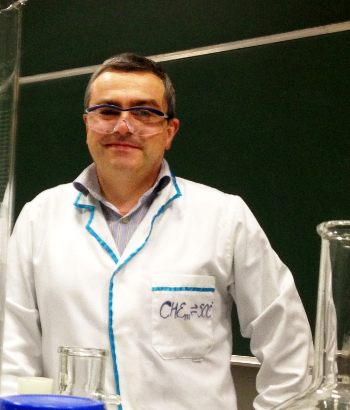Chemical catalysis is a vitally important process in the preparation of plastics, materials, pharmaceuticals and agrochemicals. Approx 80 to 90% of the products made by the chemical industry - of which the chemicals and pharmaceutical manufacturing sector has a value of £18 billion - are reliant on catalysts[1]. They can also be used to aid the reduction of emissions (for example, car exhaust catalysts).
Catalysts make reactions proceed more rapidly and at lower temperatures, increasing the efficiency of the synthetic process. Professor Ian Fairlamb and Dr Jason Lynam, working in collaboration with scientists at the Ultra laboratory at the Central Laser Facility, and Syngenta Crop Protection have pioneered a new method to study how catalysts work.
The researchers focussed on the cheap and sustainable metal, manganese, and aimed to understand how it performs the crucial step of forming carbon-carbon bonds. Normally it is not possible to observe these steps in a catalytic reaction as the compounds that perform them are extremely short-lived and may only be present in very small amounts. However, the team developed an innovative method to circumvent these problems and directly observe the species responsible for the key reaction steps.
Central to the success of the approach has been the application of laser facilities at the Ultra laboratory. The Ultra laser system was applied to a catalyst in order to activate it. This triggers the generation of substantial amounts of the catalyst intermediates so that their behaviour can be observed. This allows the reactions to be studied over a wide range of timescales, from extremely short (picoseconds) to much longer (milliseconds) – equivalent to studying events occurring from one second to over three years in a single experiment!
As Dr Lynam points out:
'Being able to observe the key steps which are involved in the reactions of a sustainable metal like manganese for the first time is extremely exciting.'

Dr Jason Lynam and Professor Fairlamb have been returning users of the Ultra Laser Facility for 3 years.
'I am delighted that Dr. Lynam and Prof. Fairlamb's research in unravelling the complexities of catalytic chemistry has been enabled using Ultra. ' says Head of Ultra Prof. Mike Towrie, ''The Ultra group has been working with Jason and Ian for a number of years now and happily we're set to continue with their recent award of programme access to Ultra over the next 3 years.'
As a result of this approach, the team has directly observed the short-lived intermediates responsible for carbon-carbon formation, gaining a detailed understanding of their structure and function. This knowledge will enable new, more active, catalysts to be developed, thus improving efficiency.
As Professor Ian Fairlamb explained:
'This work has uncovered some really surprising steps that underpin catalysis and will significantly aid with the development of new, highly active sustainable catalysts for chemical synthesis.'
This work was supported by direct access to the Central Laser Facility. Is it also funded by Syngenta through an EPSRC iCASE award. The research is published in Nature Catalysis (link: http://dx.doi.org/10.1038/s41929-018-0145-y )
Contact details of sender: jason.lynam@york.ac.uk
Image within article: Dr Jason Lynam (credit to York University)
